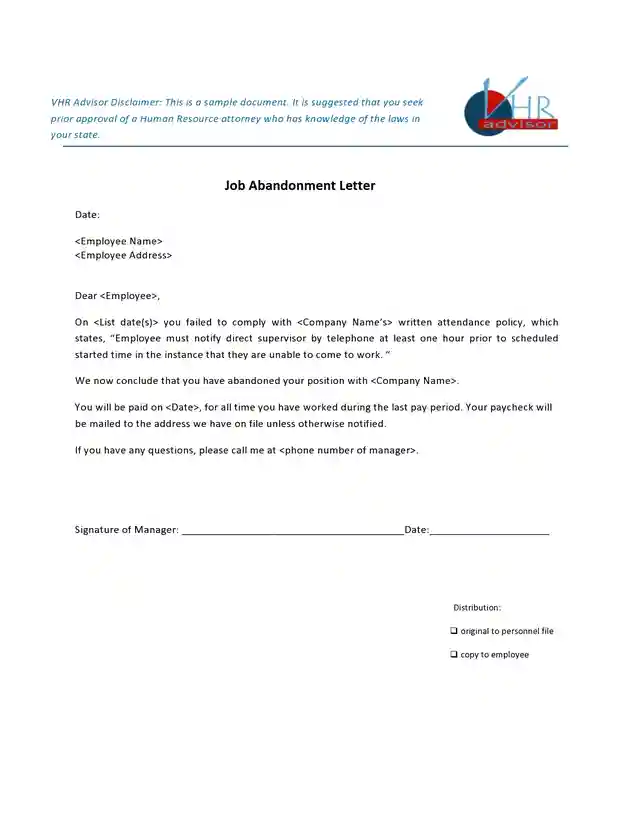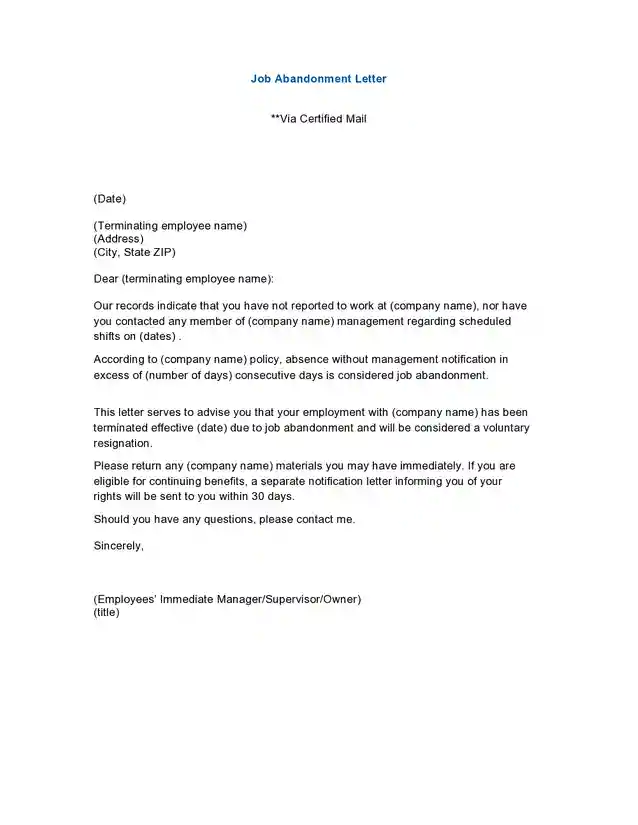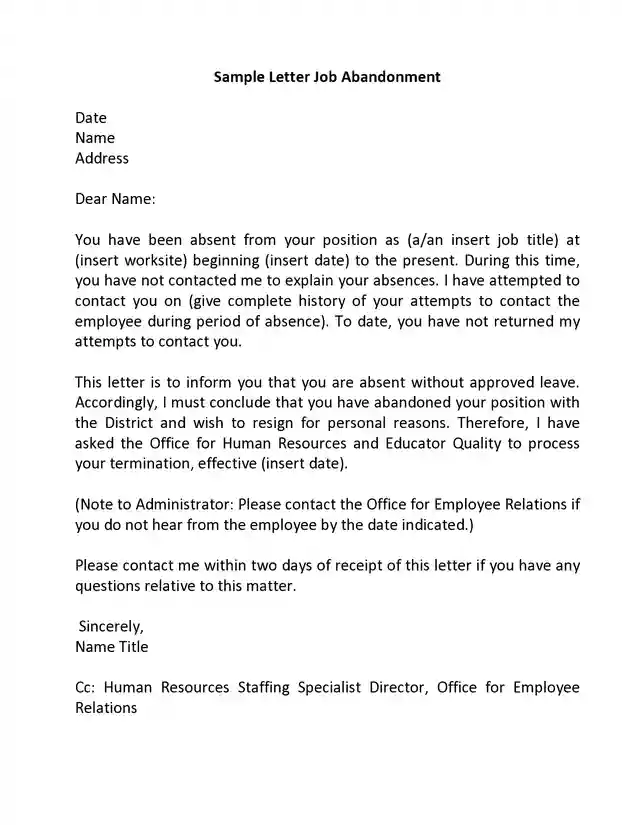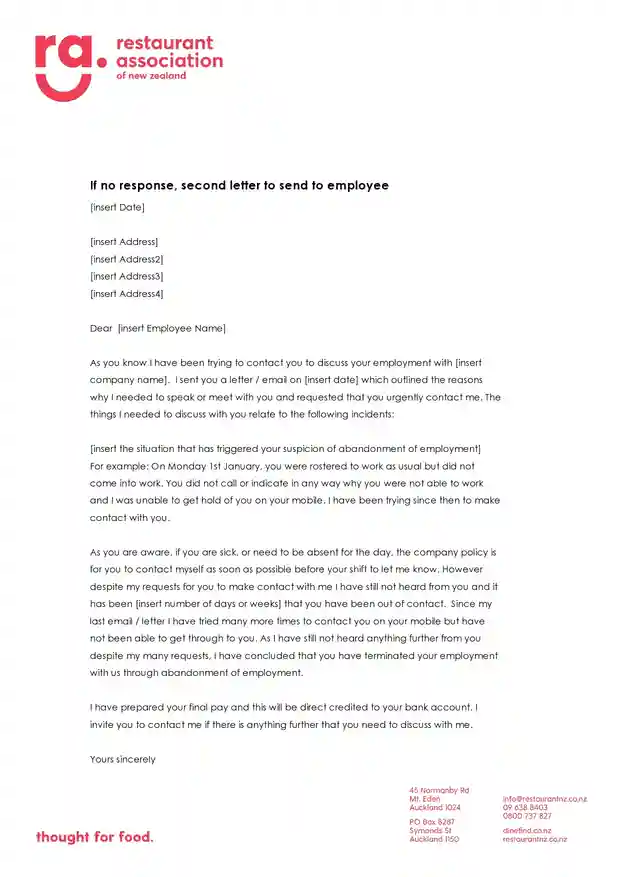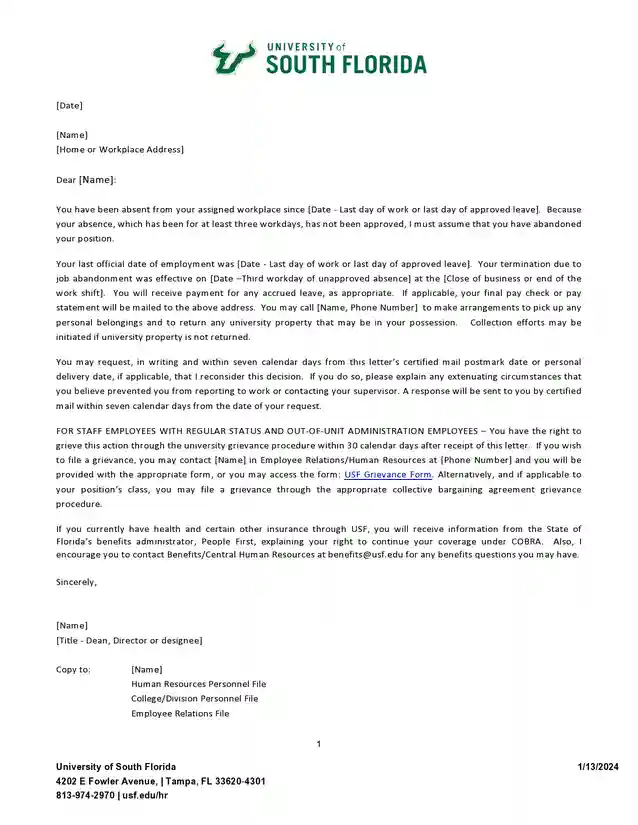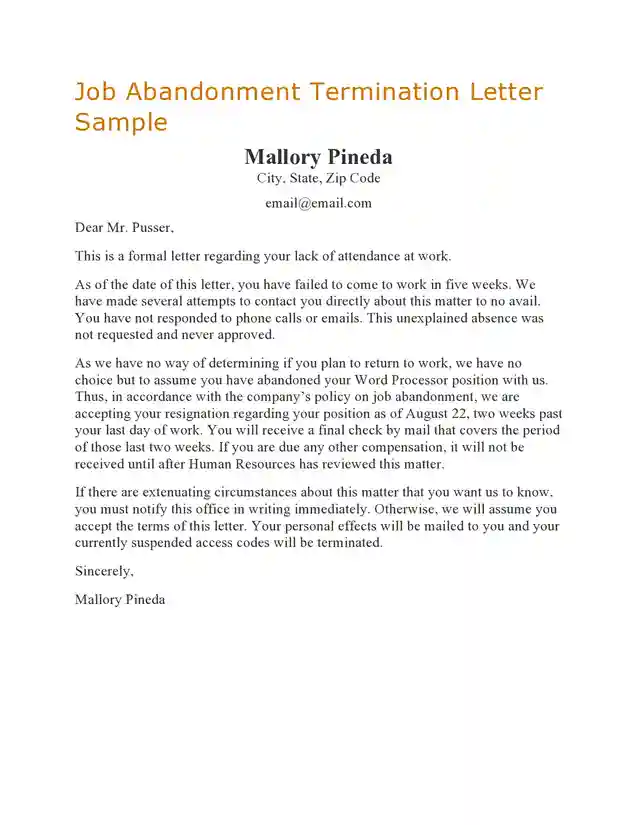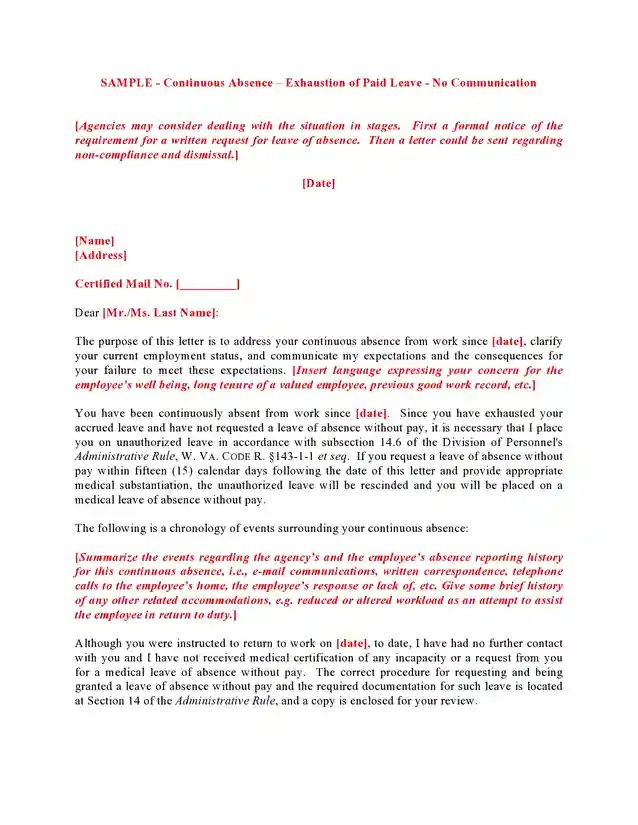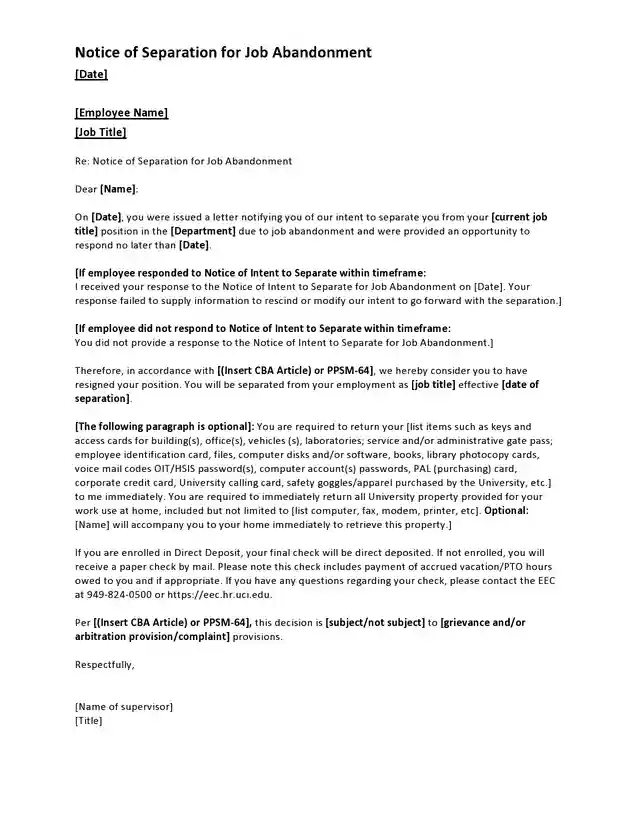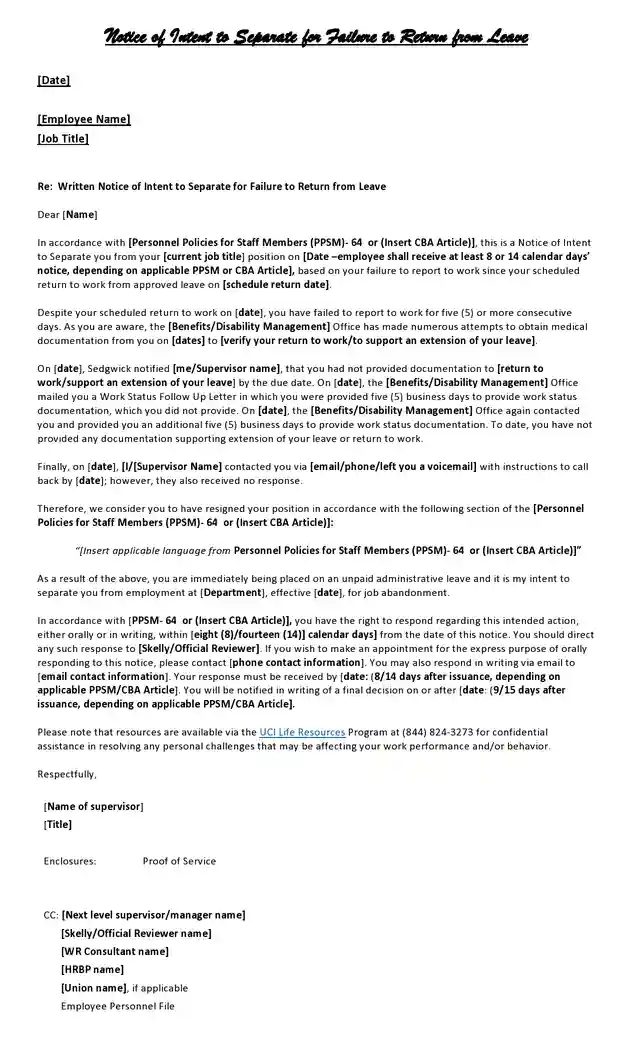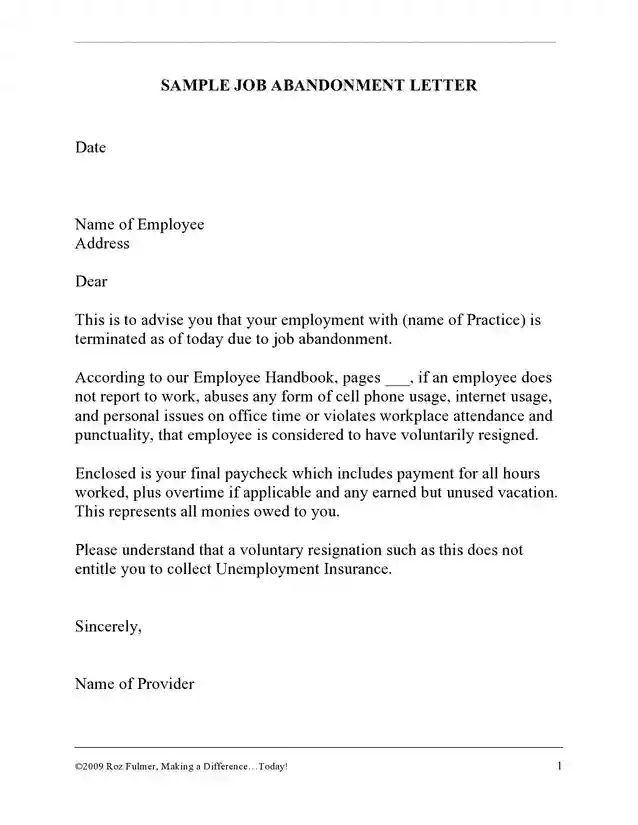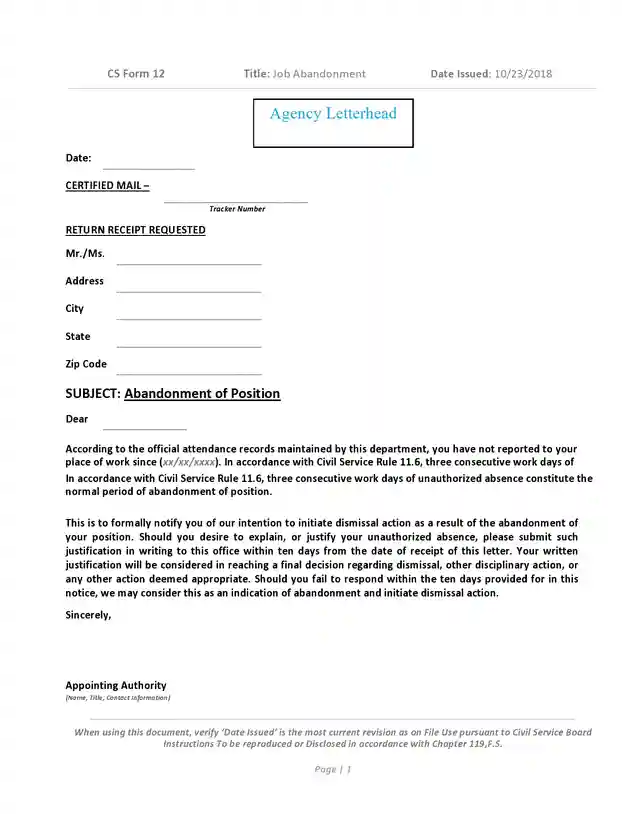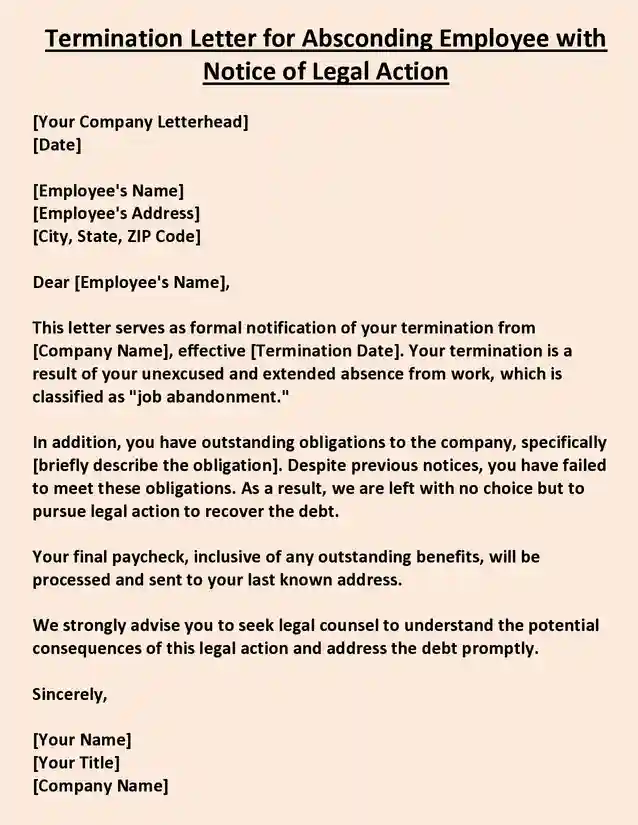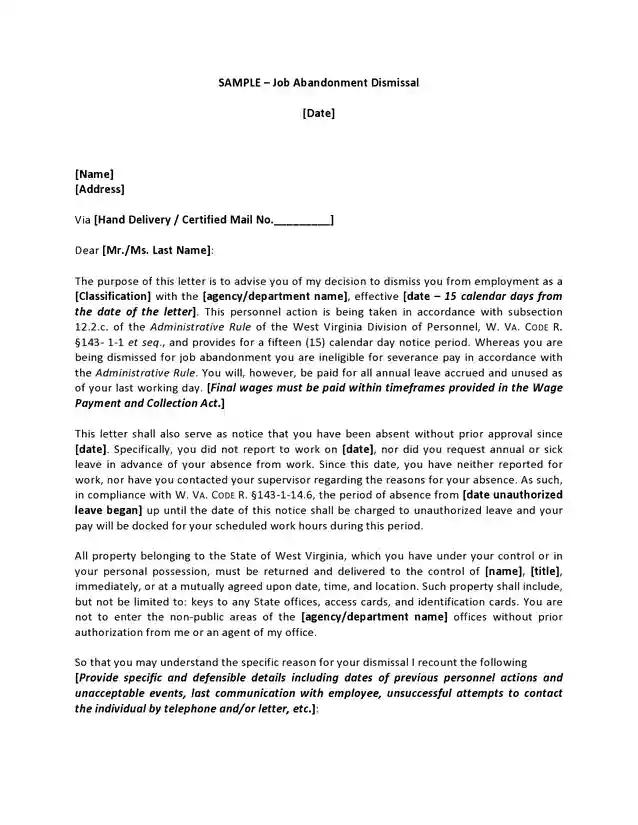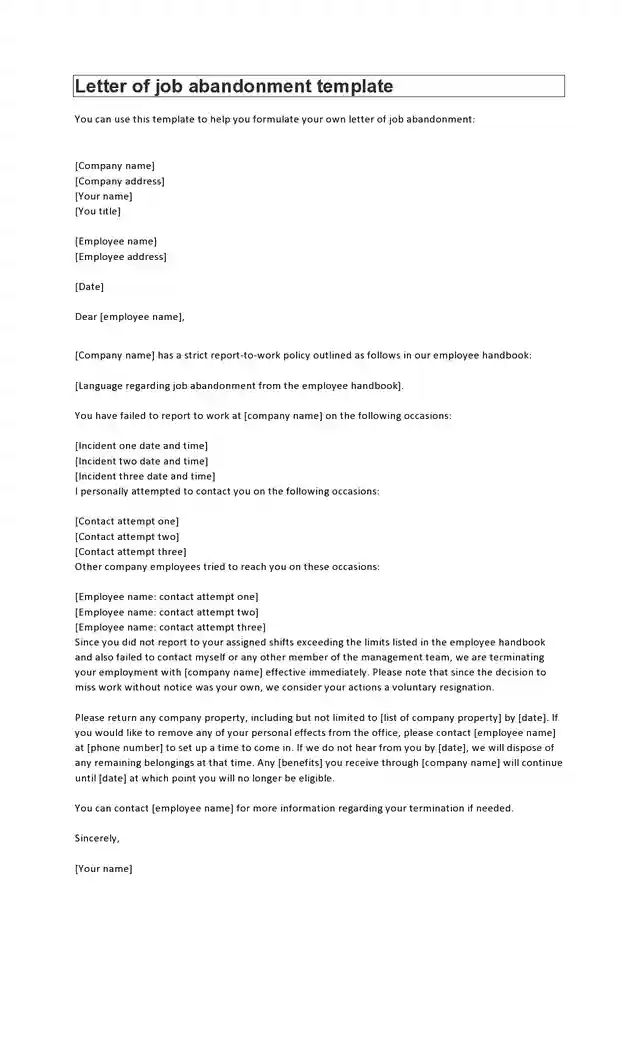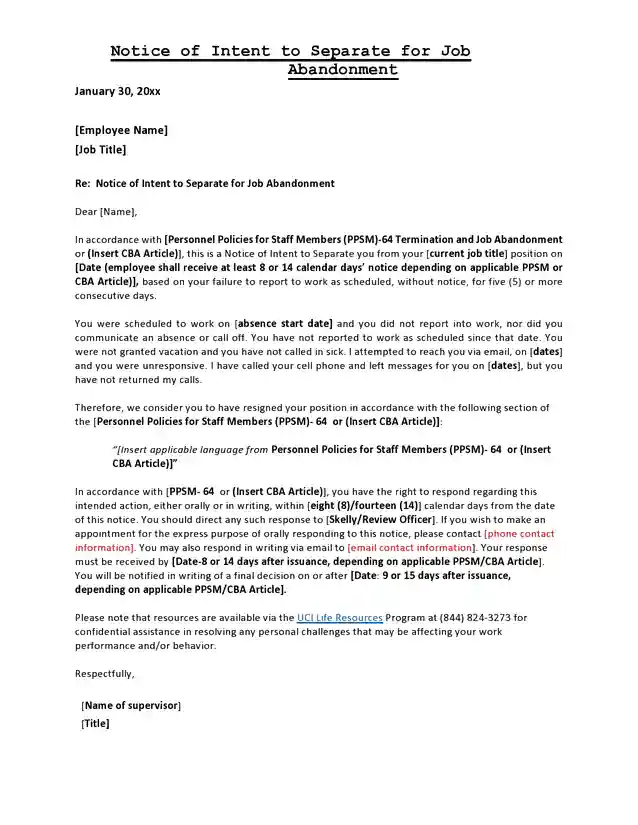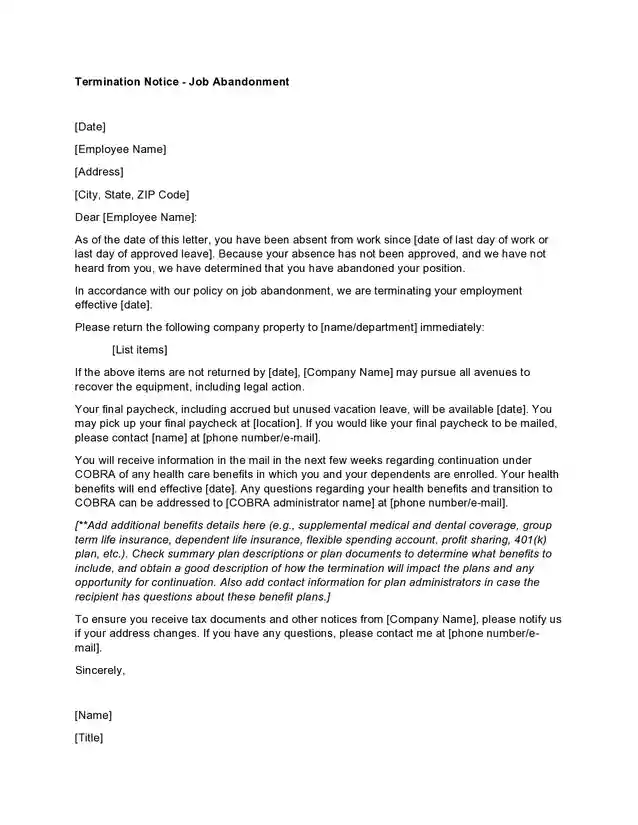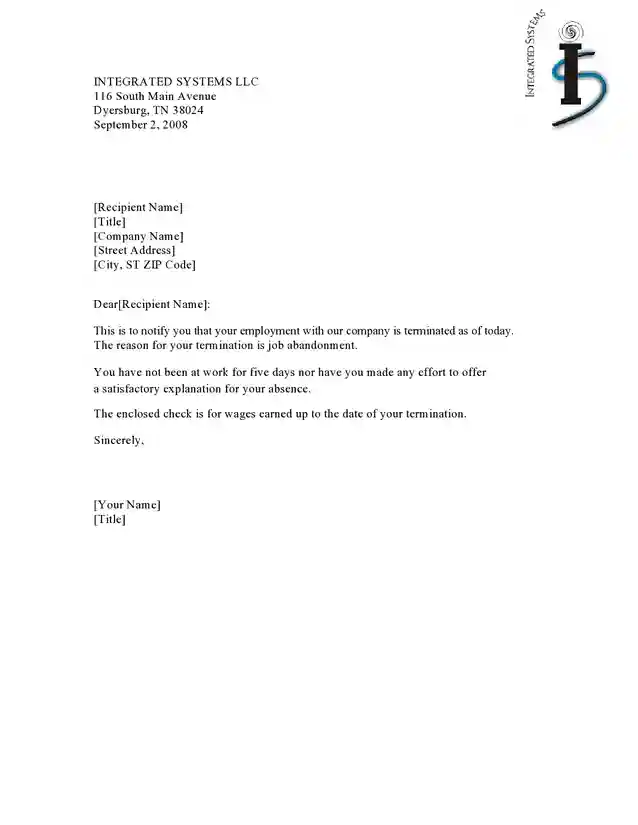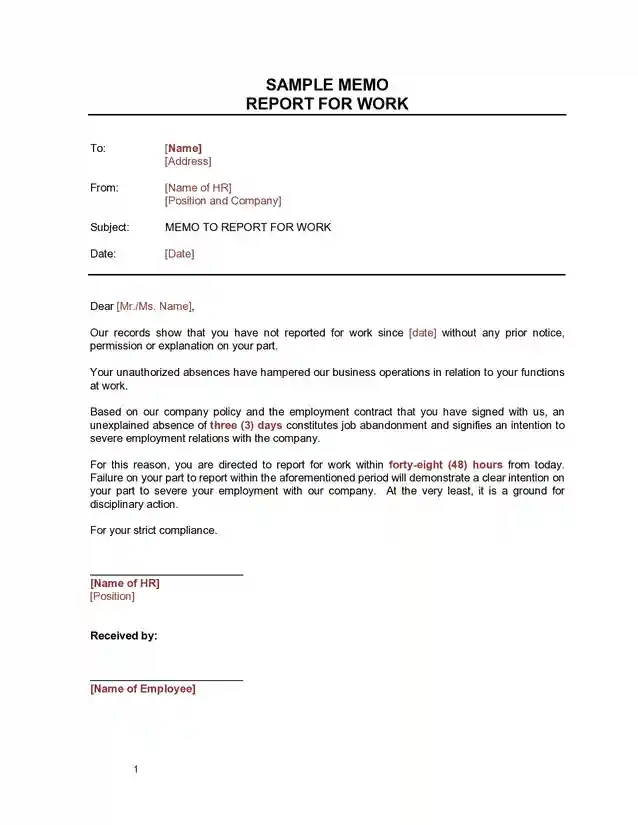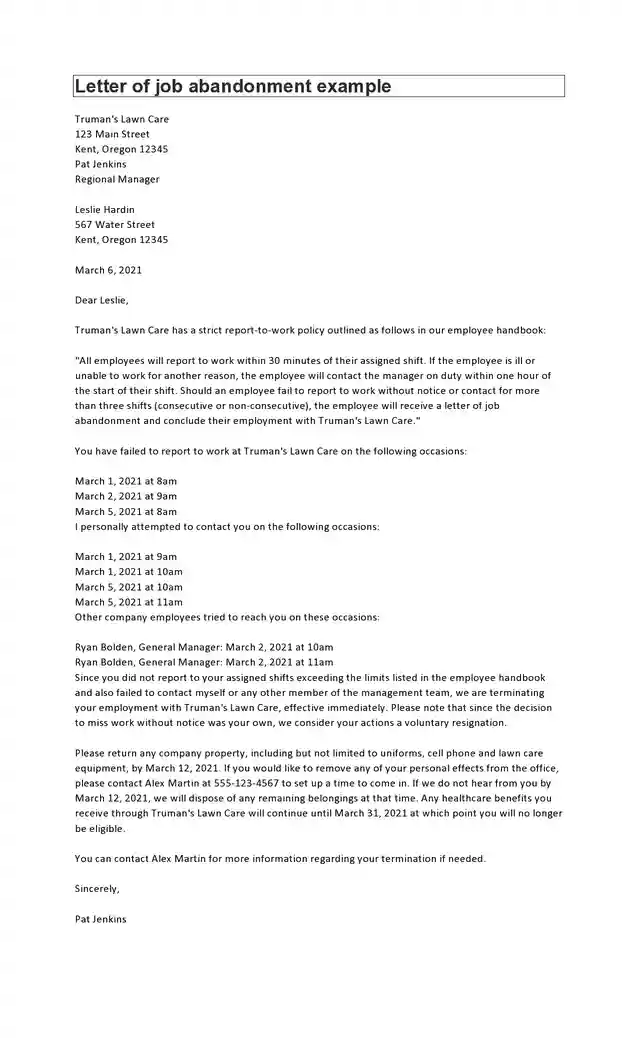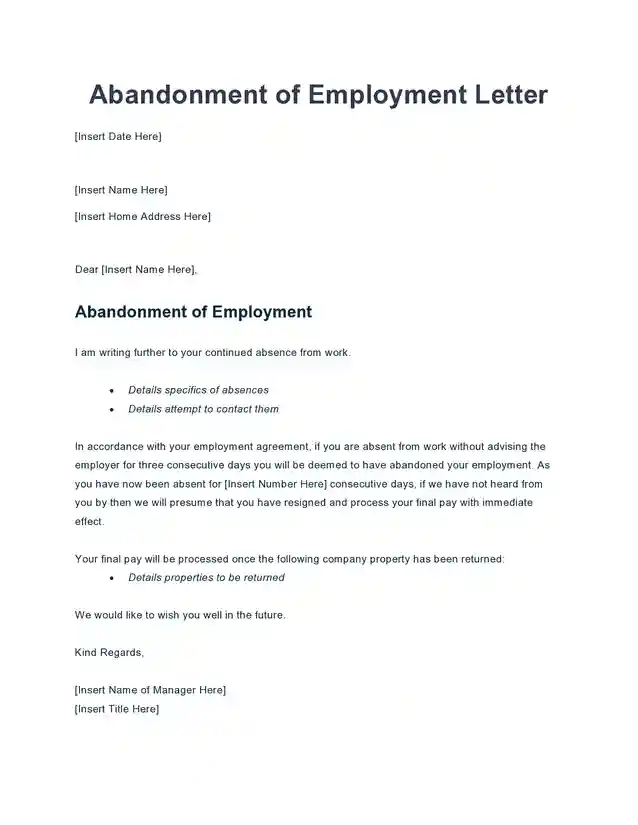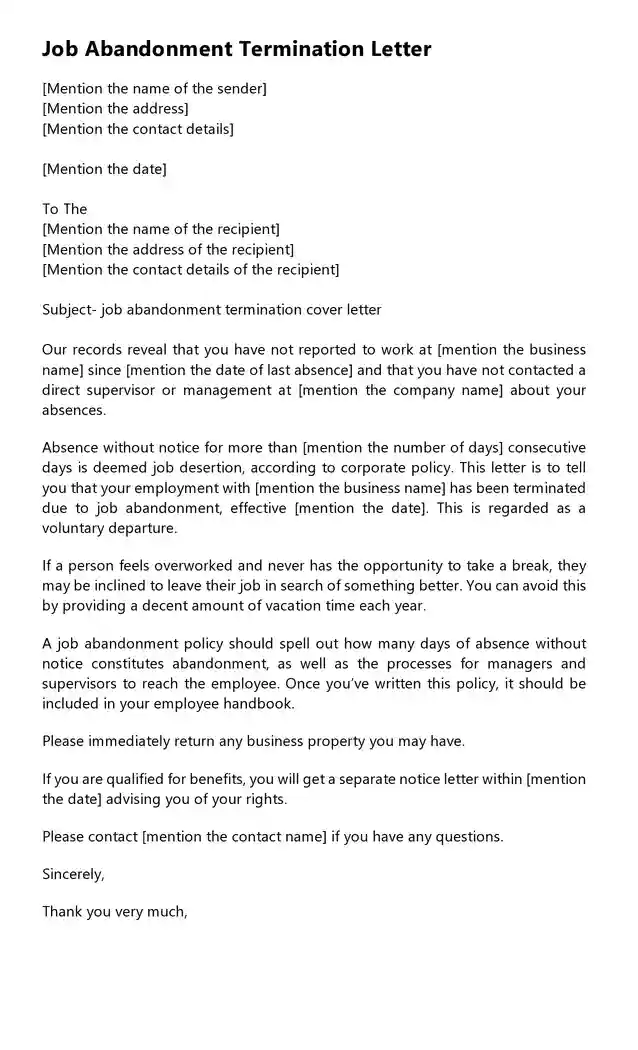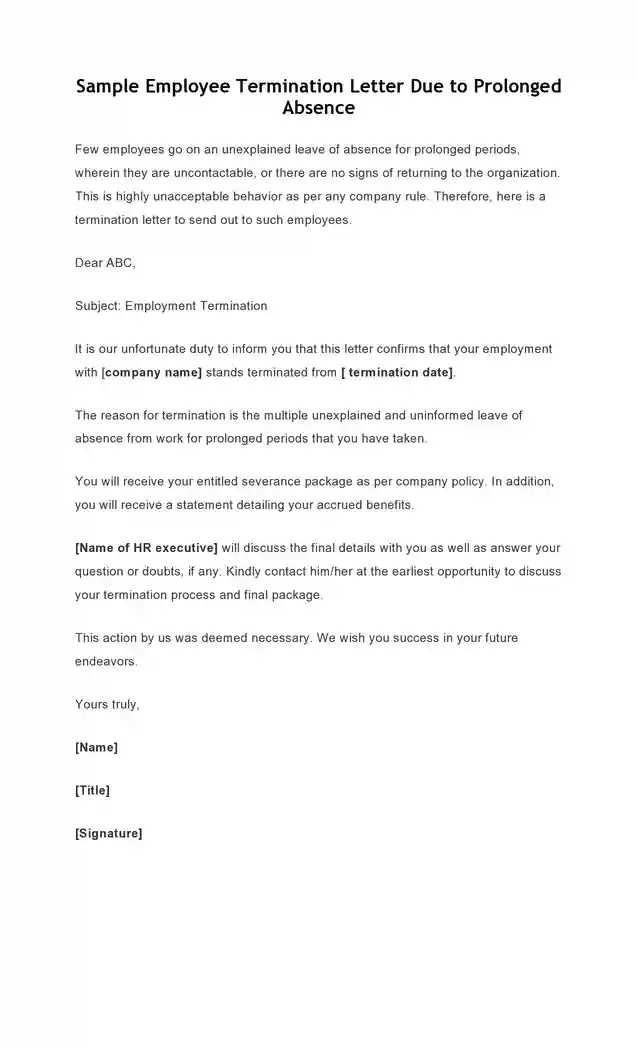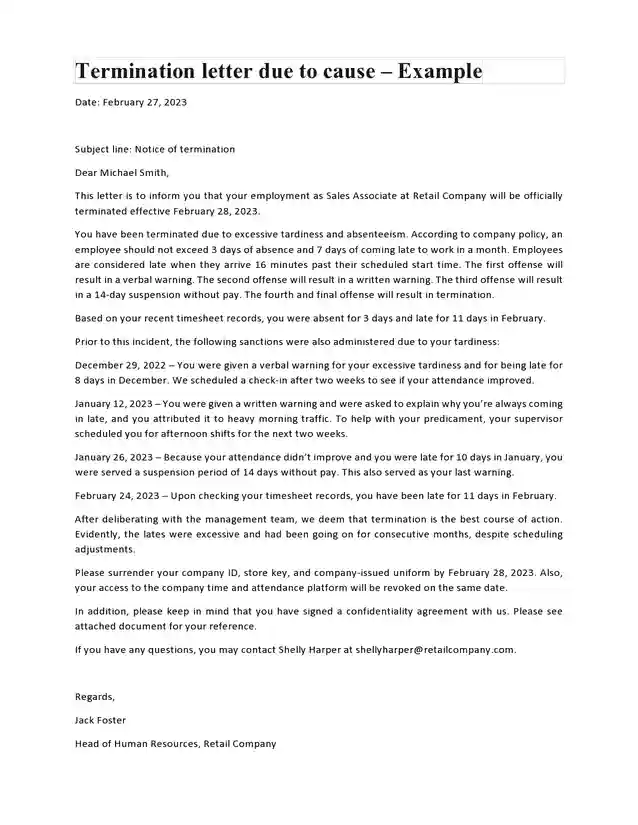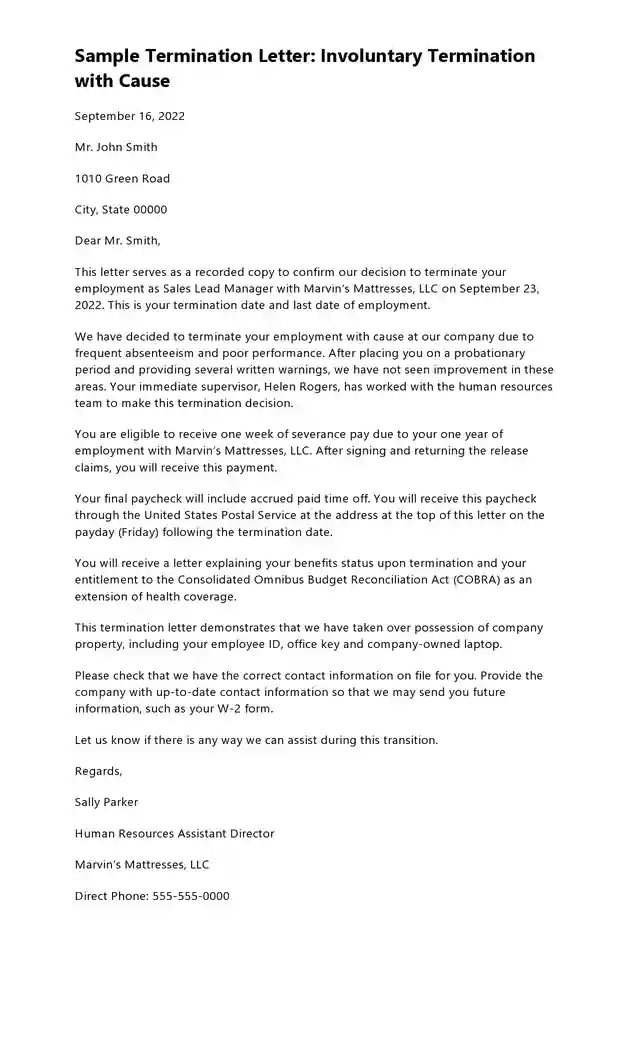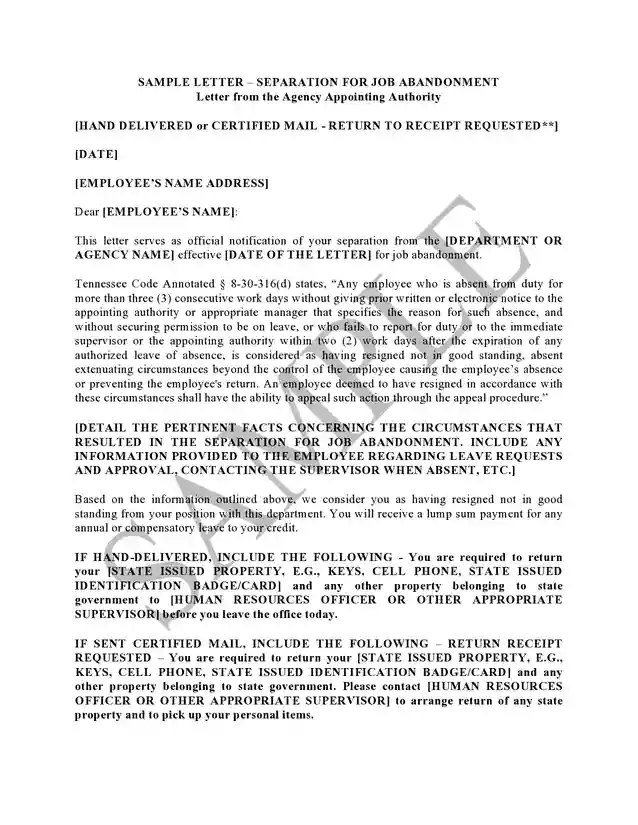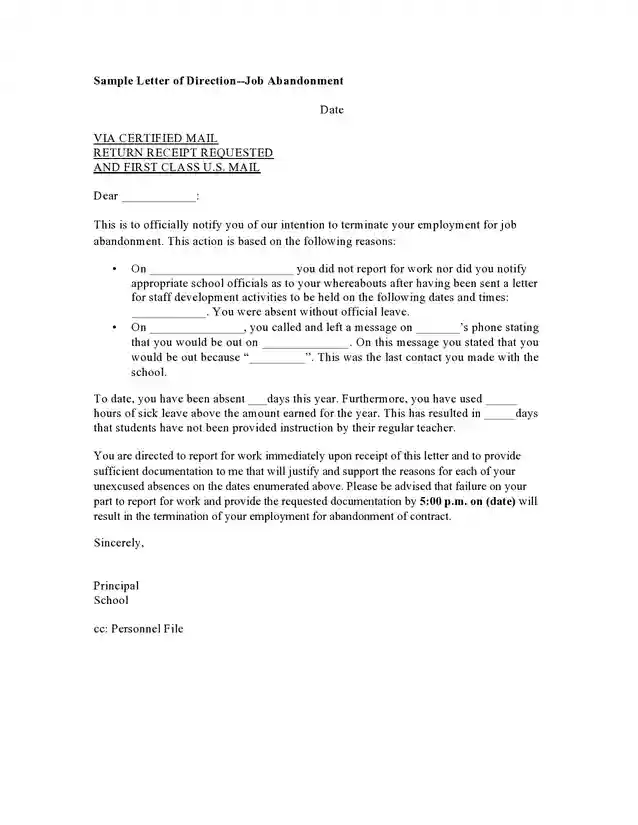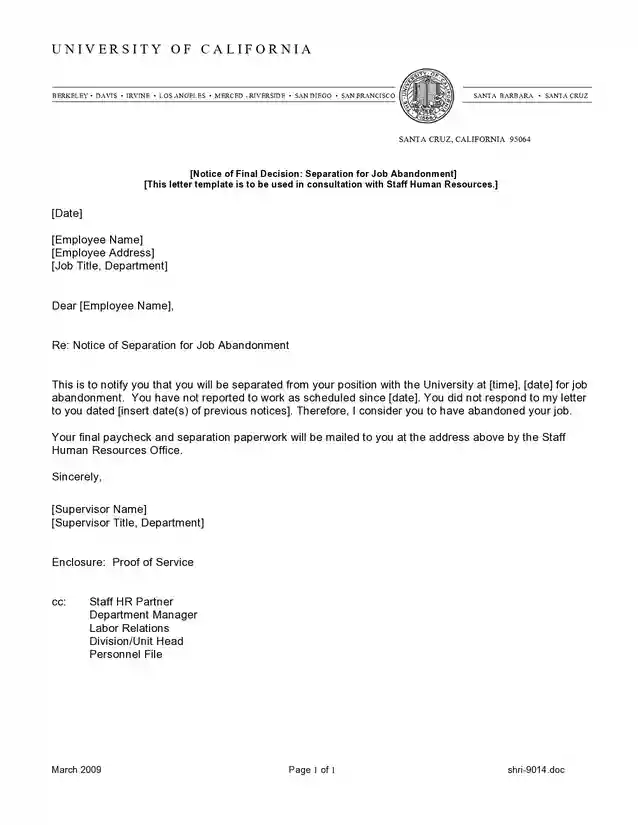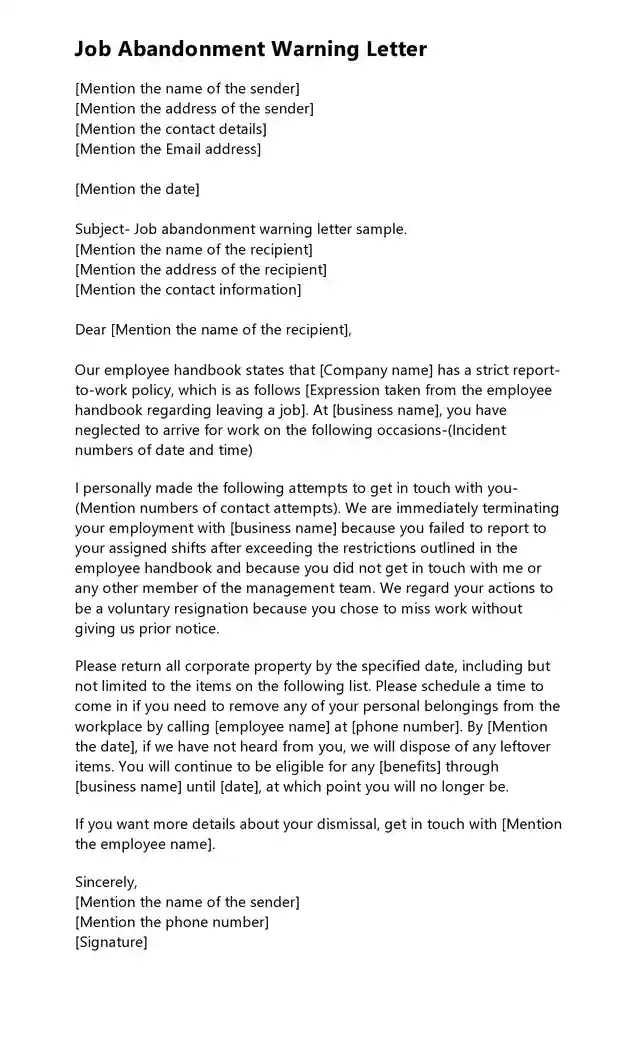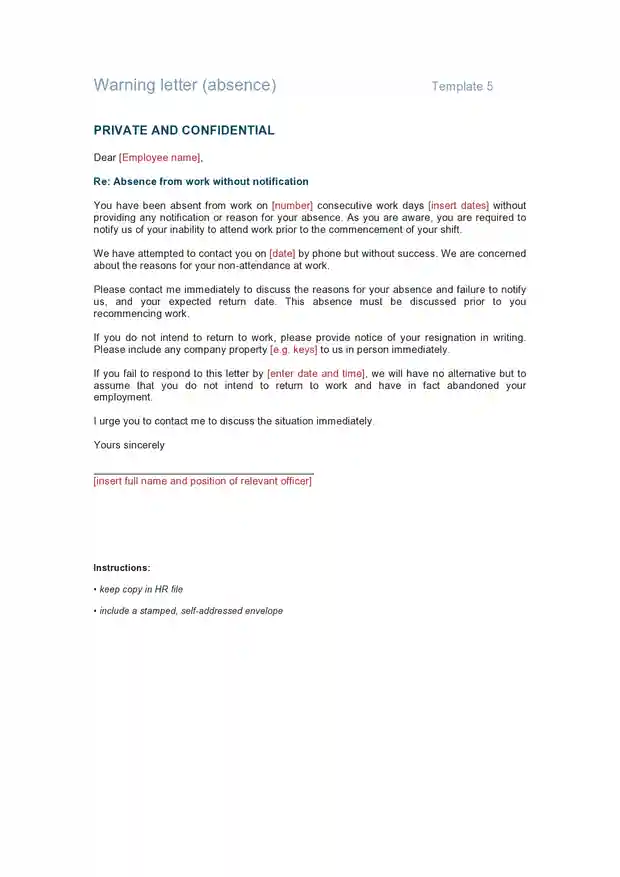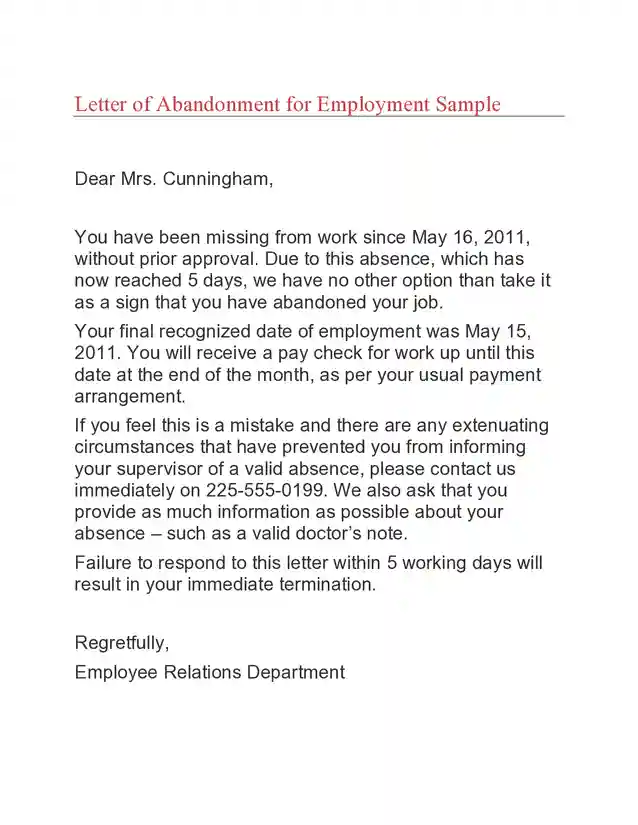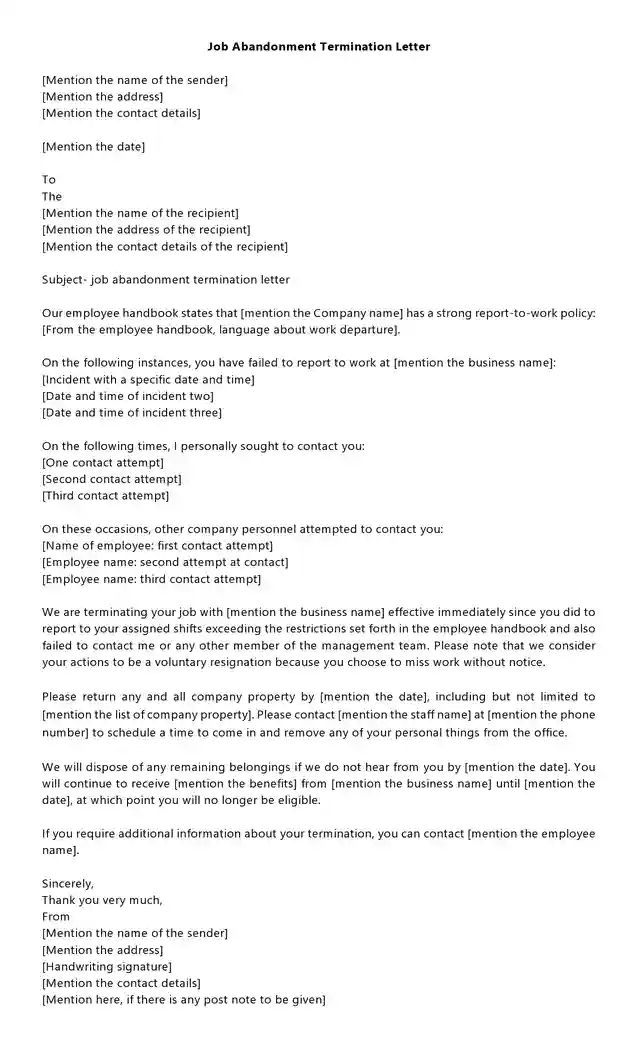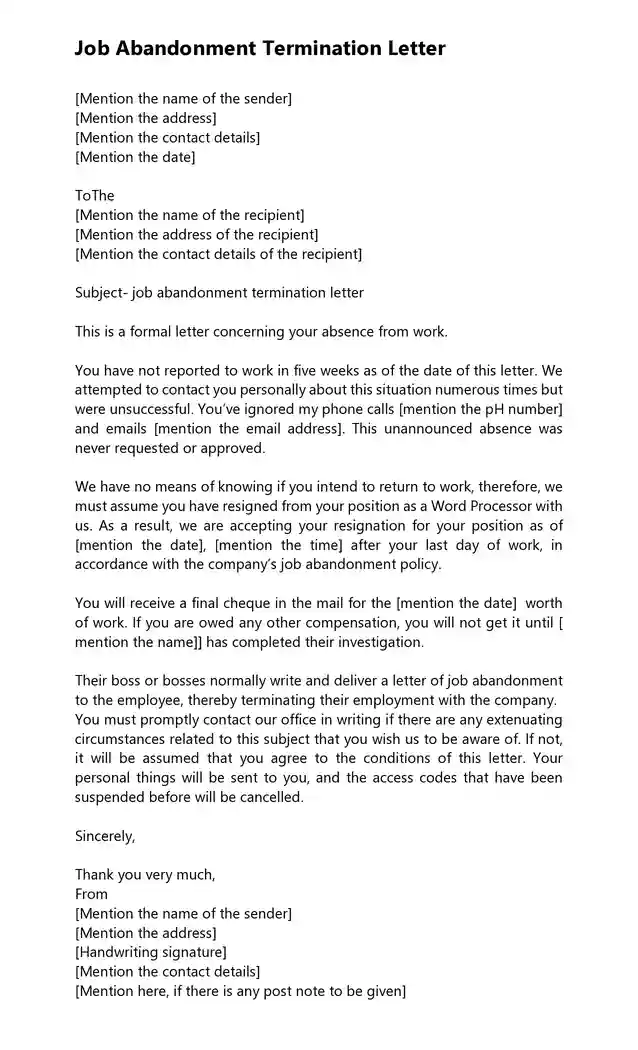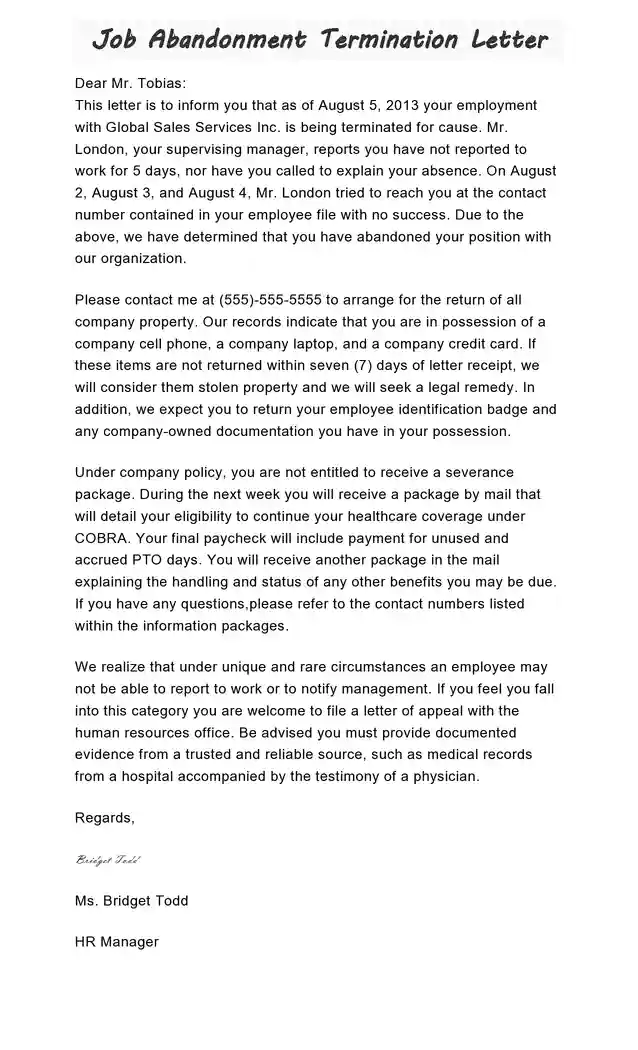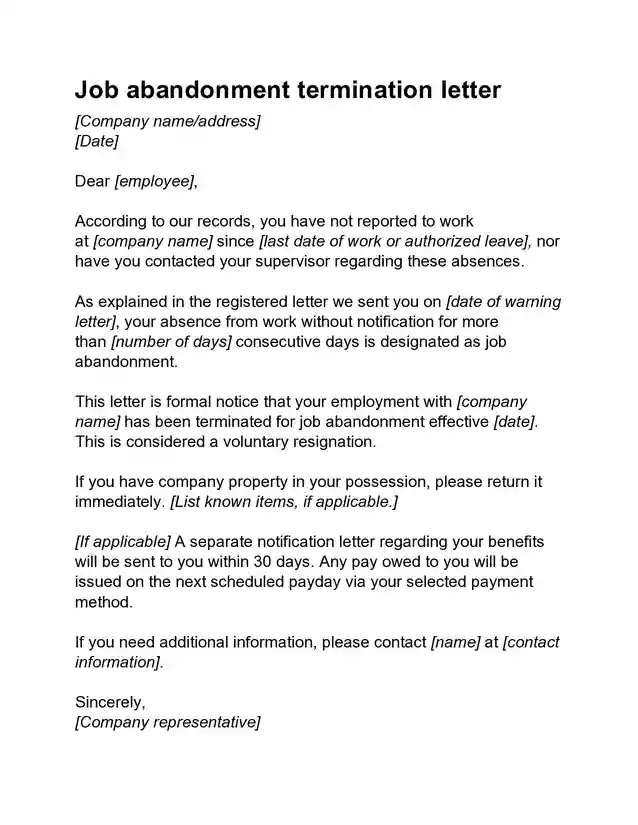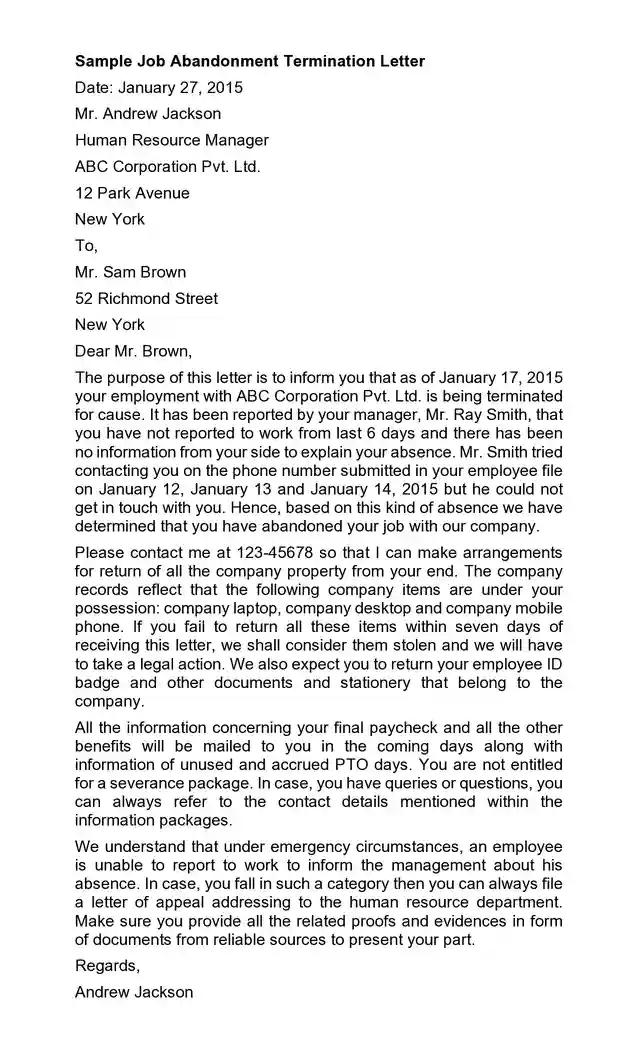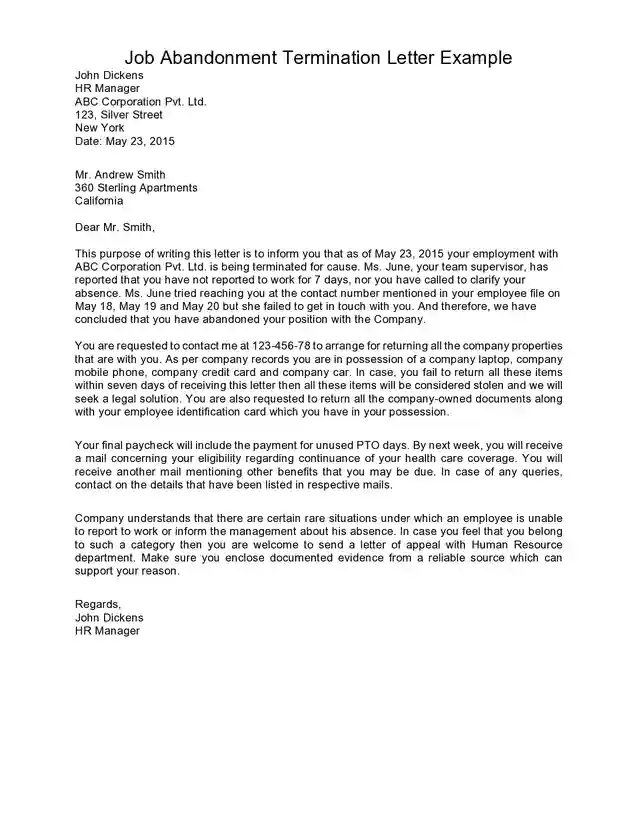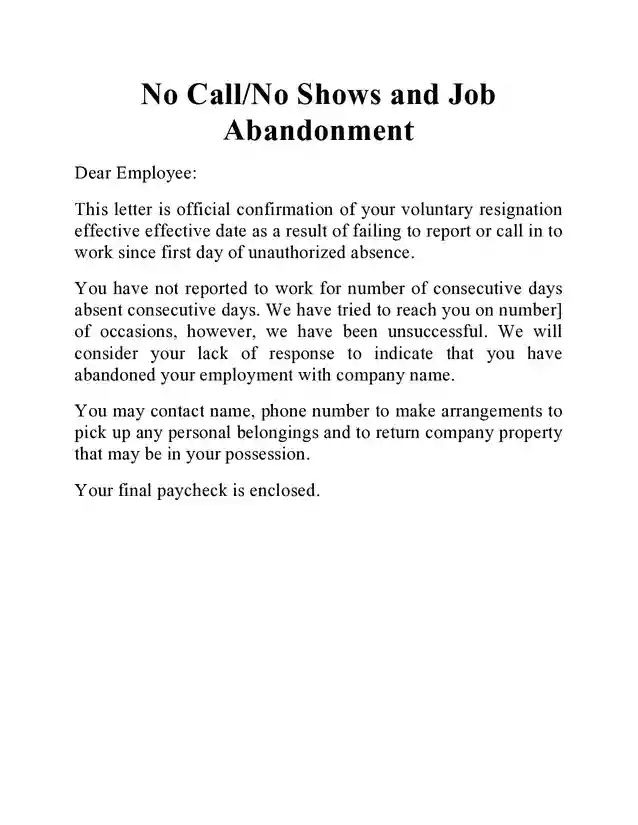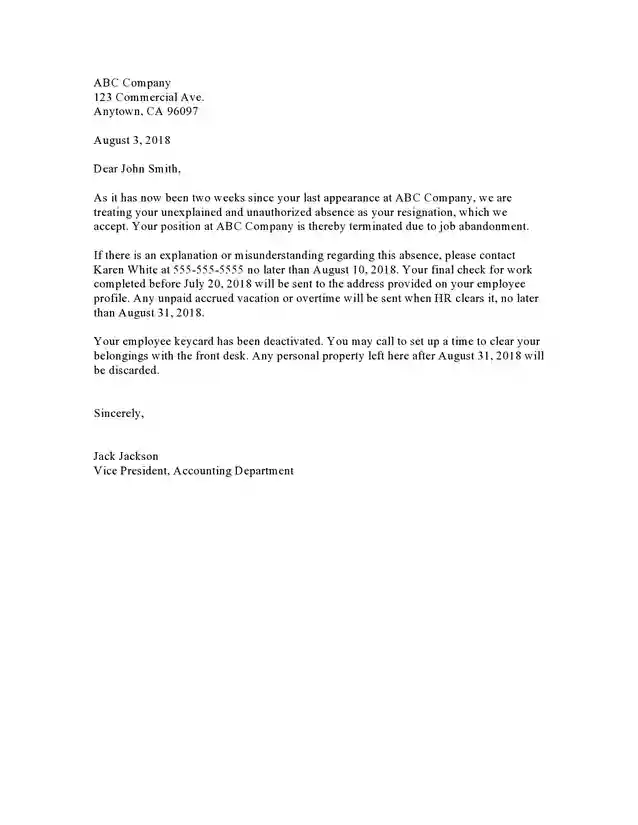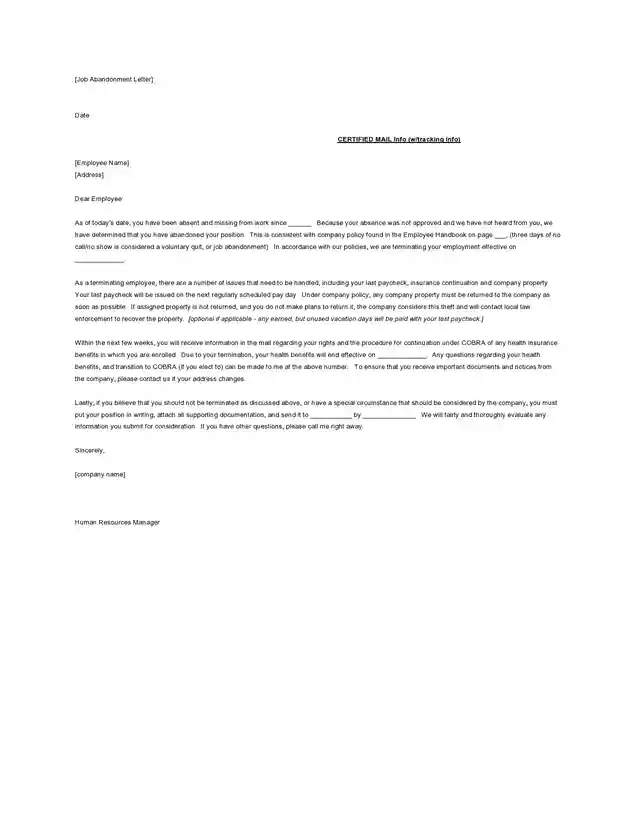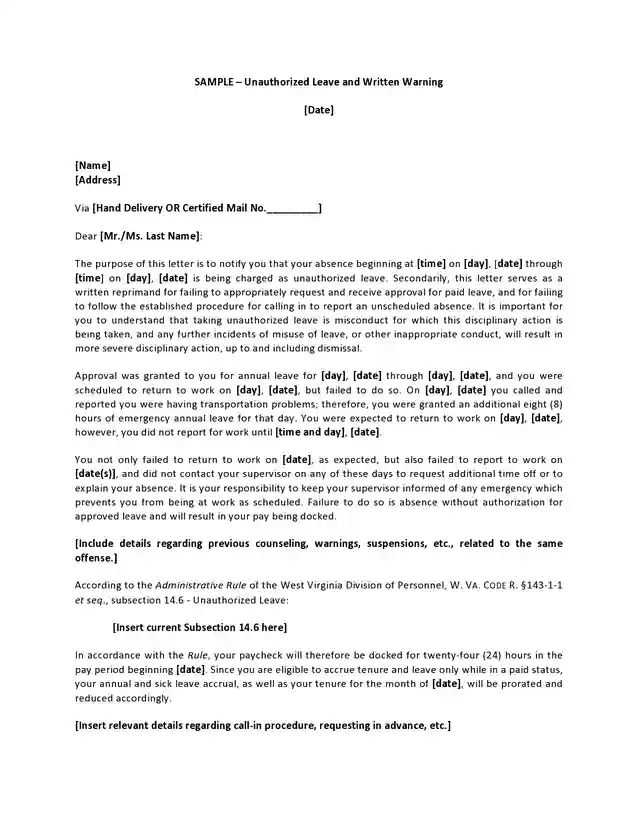One of your top employees, who has always been punctual and reliable, suddenly stops showing up for work. Days go by, and there’s no call, no email. You’re left wondering, “What happened? Did they quit? Are they okay?” This is a classic case of job abandonment, which can be stressful for any employer. In such cases, it is crucial to officially document a job abandonment letter sample and take the necessary steps.
What is Job Abandonment?
Job abandonment occurs when an employee stops coming to work without any notification. They don’t call in, send a message, or provide any notice. The company then assumes the employee has quit because they no longer show up.
Common Reasons for Job Abandonment
There are several reasons why an employee might abandon their job:
- Personal Problems: Family issues or health problems can make it difficult for someone to come to work.
- New Job: An employee might find a new job and leave without notice.
- Unhappy at Work: Employees dissatisfied with their job or boss might leave without saying anything.
- Lack of Communication: Sometimes, employees feel they can’t talk to their boss about their problems, so they just leave.
Purpose of a Job Abandonment Letter
The employer sends a job abandonment letter to the employee who has stopped coming to work. The letter serves several important purposes:
- Document the Situation: It officially records the employee’s absence from work.
- Inform the Employee: It tells the employee that the company believes they have quit their job.
- Outline Next Steps: It explains what the employee needs to do next, such as returning company property.
When to Send a Job Abandonment Letter
It’s important to know when to send the letter. Sending it at the right time helps clear up any confusion and keeps things fair for everyone.
How Long Should You Wait?
Before sending, wait a few days. This gives the employee a chance to come back or explain their absence. Most companies wait about three to five days. During this time, try to contact the employee through phone, email, or message.
What to Do If You Can’t Reach the Employee?
If you can’t reach the employee after trying to contact them, it’s time to send the letter. This letter tells the employee that the company thinks they have quit and explains what they should do next.
Steps to Follow:
- Check Records: Ensure the employee has not requested time off or given notice.
- Contact the Employee: Try to call or email the employee. Leave a message if they don’t answer.
- Wait a Few Days: Give the employee three to five days to reply.
- Send the Letter: If there is no reply, send the job abandonment letter. Use certified mail or email with a read receipt.
Why Timing Matters:
- Fairness: Waiting a few days and trying to contact the employee shows fairness.
- Clear Communication: Sending the letter promptly ensures the employee knows what’s happening.
- Legal Protection: It helps protect the company in case of legal questions later.
Contents of a Job Abandonment Letter
A job abandonment letter needs to include essential details to make everything clear:
1. Employee’s Name and Position
Include the employee’s full name and job title.
2. Dates of Unexcused Absence
List the dates when the employee was not at work without notice.
3. Statement of Job Abandonment
Clearly state that the company assumes the employee has quit their job.
4. Next Steps or Final Payments
The letter should also tell the employee what to do next. This could include:
- Returning any company property, like keys or equipment
- Contacting the human resources department for any final paperwork
- Information about their final paycheck and when they will receive
- a job abandonment letter can help ensure everything is handled correctly and fairly.
Is a Job Abandonment Letter Legally Required?
It might only sometimes be required by law, but it is essential. Having this letter helps everyone understand what happened. It also shows that the company followed the proper steps.
Differences Between a Job Abandonment Letter and a Termination Letter
There are significant differences between a job abandonment letter and a termination letter.
Job Abandonment Letter
- Employee’s Action: It is used when the employee stops coming to work without telling anyone.
- Assumption: The letter assumes the employee has left the job alone.
- Purpose: It documents that the employee did not show up or communicate.
Termination Letter
- Employer’s Decision: It is used when the employer ends the employee’s job.
- Reason Given: The letter clearly explains why the job is ending.
- Formal End: It formally tells the employee that their job is ending.
Why the Differences Matter:
- Understanding: Helps the company and the employee understand the action being taken.
- Proper Process: This shows that the company followed the right steps for each situation.
- Legal Clarity: Helps avoid any legal problems by clearly documenting what happened.
Using these letters correctly helps ensure everything is transparent and fair for the company and the employee.
Responding to a Job Abandonment Letter
If an employee gets a job abandonment letter, they still have a chance to respond. Sometimes, there are good reasons why someone did not come to work or contact the company.
Steps for Employees:
- Respond Quickly: As soon as the employee gets the letter, they should reply. This helps to sort out any mix-ups fast.
- Explain the Absence: The employee should explain why they were absent. Maybe they were sick or had a family emergency.
- Provide Proof: The employee should prove why they couldn’t come to work or contact the boss. This could be a doctor’s note or other documents.
- Ask for Understanding: The employee can ask the company to understand their situation and reconsider their job status.
Why It’s Important:
- Clearing Misunderstandings: Responding quickly helps to clear up any misunderstandings.
- Protecting Job: It might help the employee keep their job if the reason for absence is valid.
- Maintaining Records: Having a response on file helps the employee and the company keep clear records.
By sending a letter, the company ensures it handles the situation correctly. The employee can explain their side and resolve the issue by responding.
How to Deliver a Job Abandonment Letter
Delivering it the right way is significant. Here are some excellent ways to provide the letter:
- Certified Mail: Sending the letter with a return receipt ensures the employee receives it. You get proof that the letter was delivered.
- Email: Sending the letter by email with a read receipt is another option. This also provides proof that the employee received and read the letter.
- In-Person: Handing the letter to the employee in person is a direct way to ensure they get it. Have a witness present to confirm the delivery.
Importance of Proper Delivery
Proper delivery of the letter is crucial for several reasons:
- Proof of Delivery: It ensures there is proof that the employee received the letter.
- Clear Communication: It makes sure the employee knows about their job status.
- Legal Protection: It protects the company in case there are any legal disputes later on.
Ensuring the letter is appropriately delivered helps avoid confusion and ensures the process is fair for everyone.
Consequences for the Employee
Legal and Professional Consequences
It can have severe effects on an employee’s life. Here are some possible consequences:
- Loss of Job: The most immediate consequence is losing their job. The company no longer employs the employee.
- Legal Issues: If the employee had a contract, there might be legal issues for breaking it without notice.
- No Unemployment Benefits: Employees who abandon their jobs usually cannot get unemployment benefits because they left without a valid reason.
Impact on Future Employment
It can also affect the employee’s future job opportunities:
- Bad Reference: The company may need to provide a better reference for future employers. This can make it hard to get another job.
- Red Flag: Future employers might see job abandonment as a red flag. They may worry that the employee will do the same thing again.
- Trust Issues: It can be challenging for employees to build trust with new employers if they have a record of abandoning a job.
Understanding these consequences can help employees think carefully before leaving a job without notice. It also allows employers to explain why job abandonment is a serious issue.
Prevention Strategies
How Employers Can Prevent Job Abandonment
Employers can take steps to help prevent job abandonment. Here are some strategies that can help:
- Open Communication: Encourage employees to talk about their problems or concerns. This makes them feel valued and heard.
- Supportive Environment: Create a supportive work environment where employees feel comfortable sharing their issues.
- Regular Check-Ins: Regular check-ins with employees to see how they are doing and if they need help.
- Clear Policies: Ensure employees know the company policies about absences and who to contact if they need to take time off.
Best Practices for Maintaining Employee Communication
Good communication is critical to preventing job abandonment. Here are some best practices for employers:
- Listen Actively: When employees talk, listen carefully and show that you understand their concerns.
- Be Approachable: Ensure employees know they can come to you with any problems or questions.
- Resources: Offer resources like counselling or support programs to help employees deal with personal issues.
- Follow-Up: If an employee shares a problem, follow up to see if they need more help or if the situation has improved.
By using these strategies, employers can create a positive work environment and reduce the chances of job abandonment.
Job Abandonment Sample
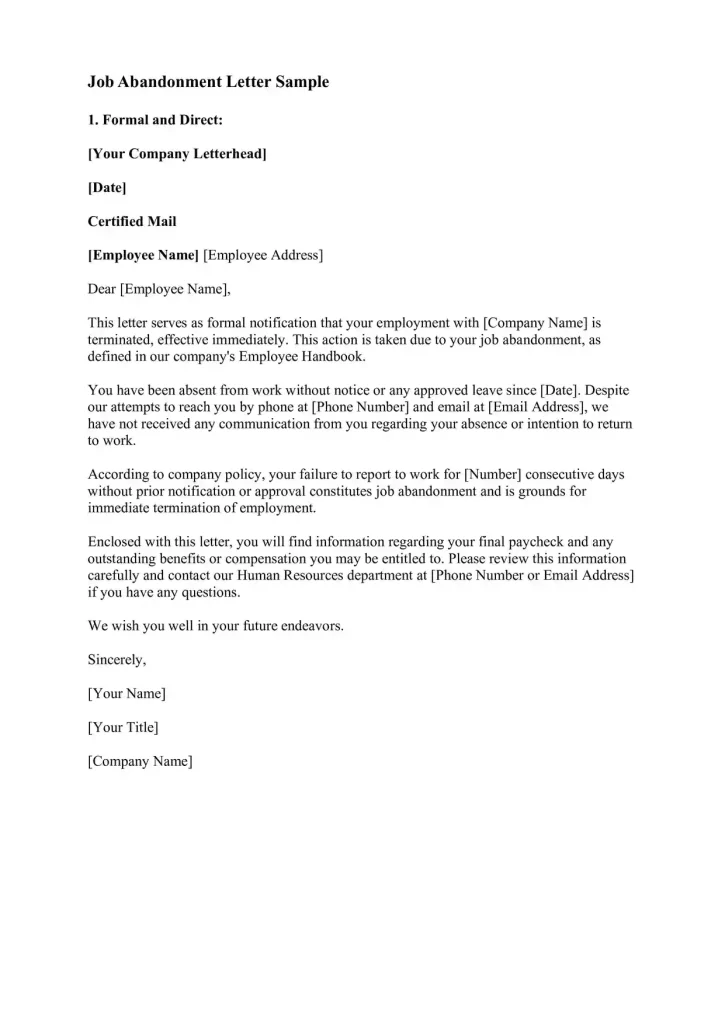
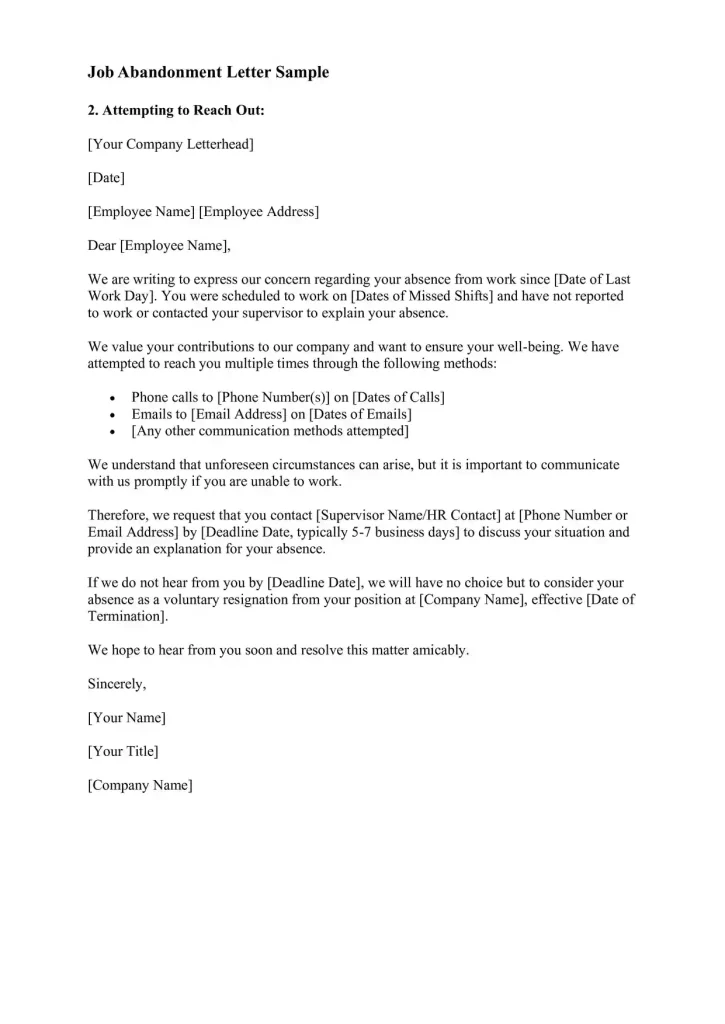
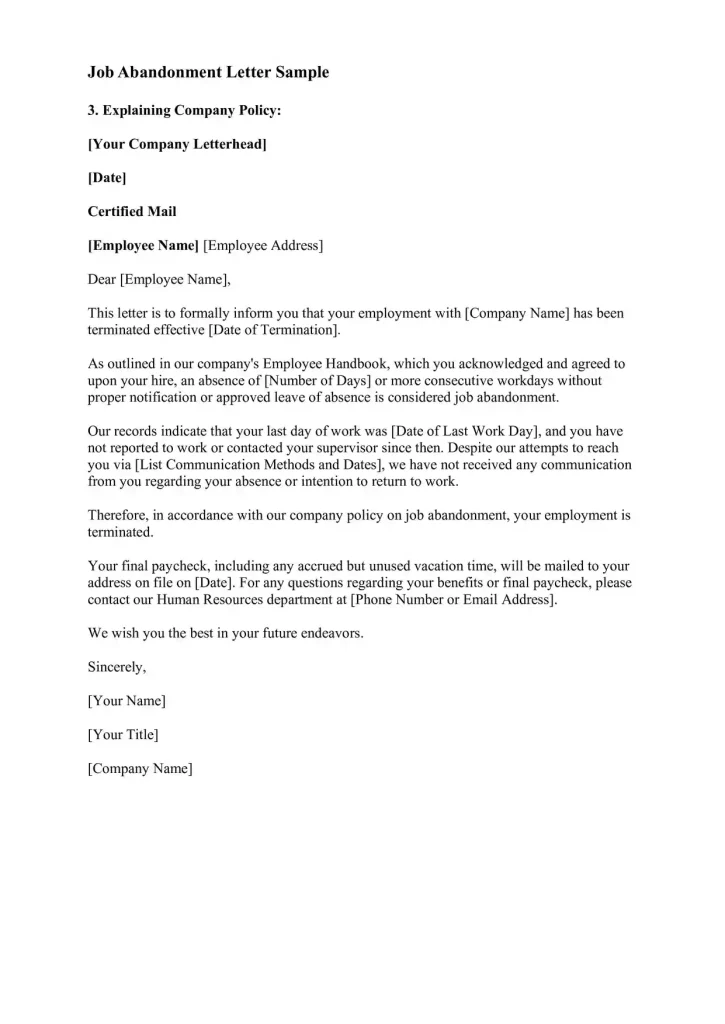
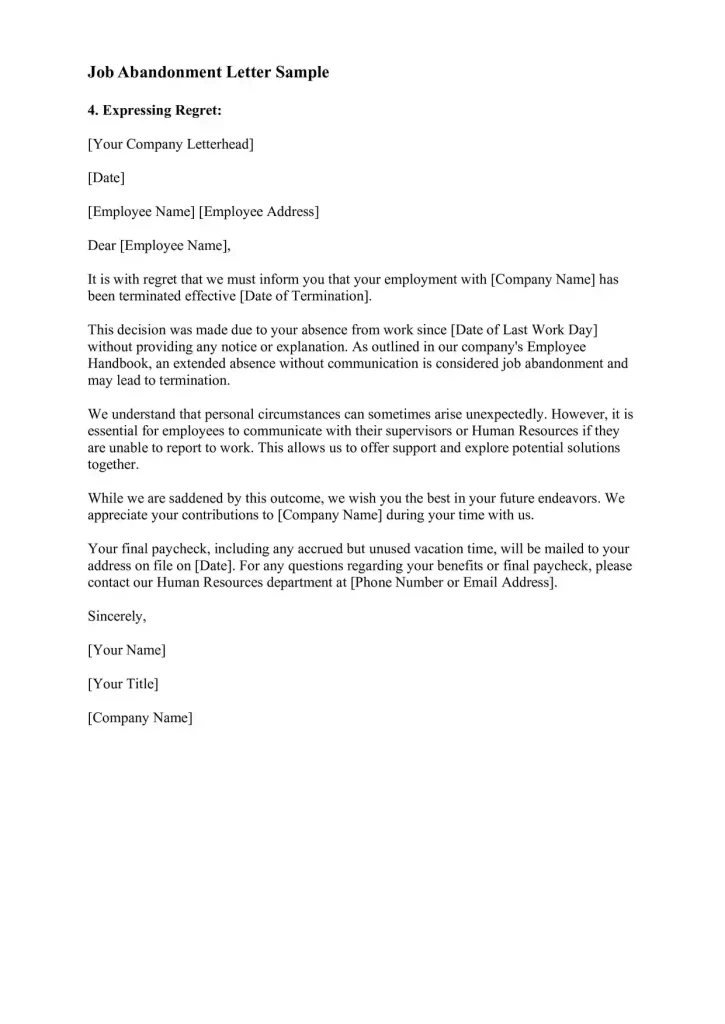
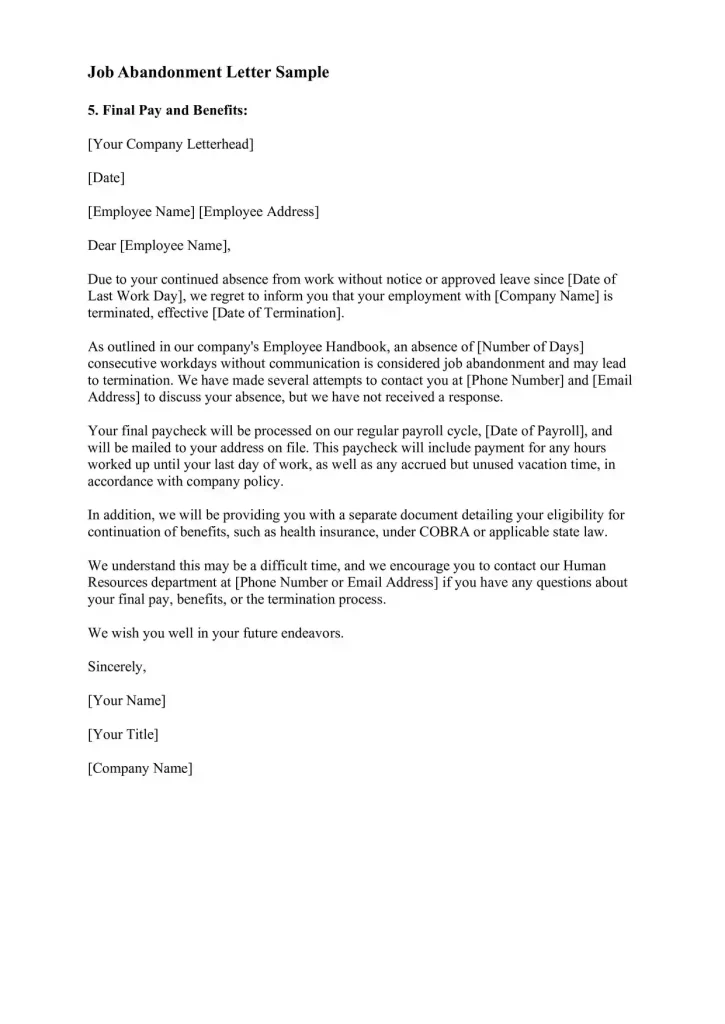
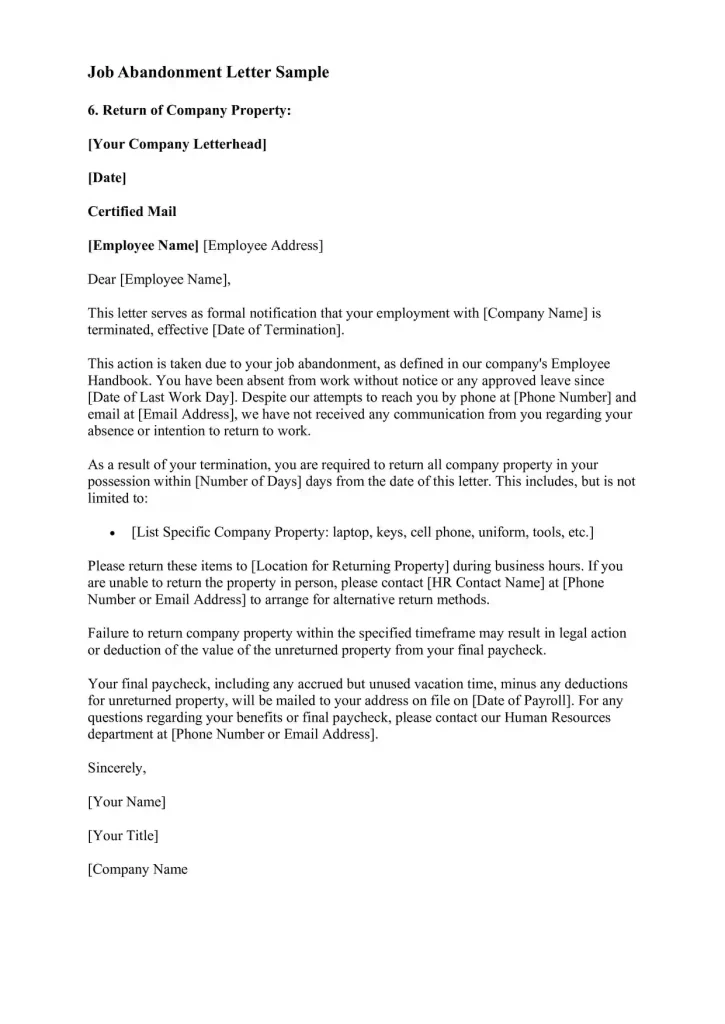
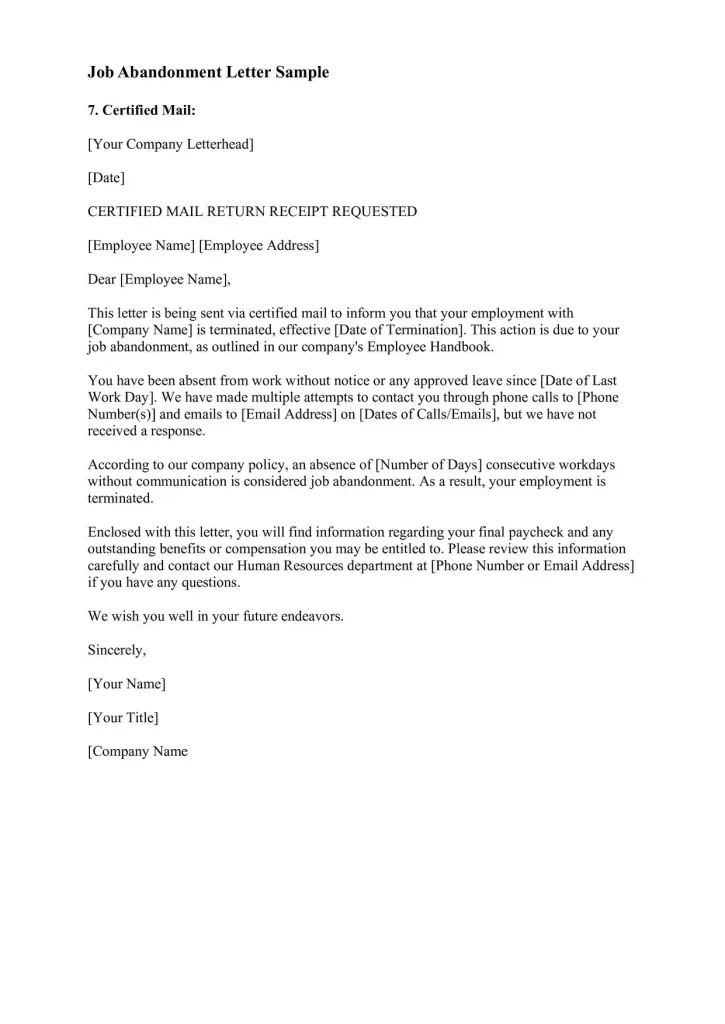
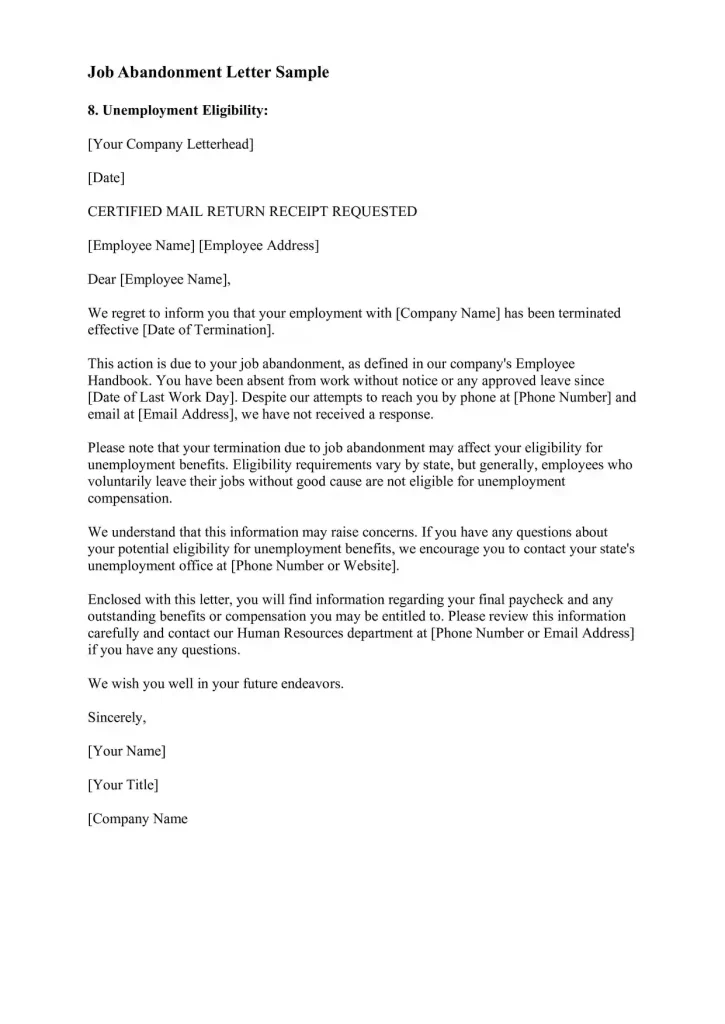
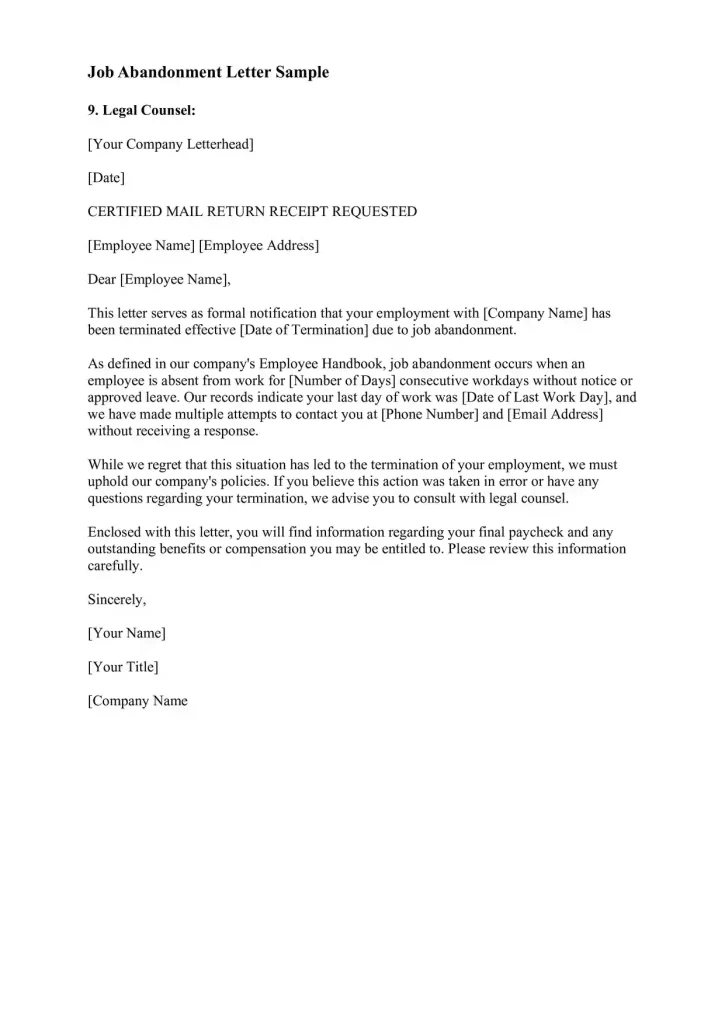
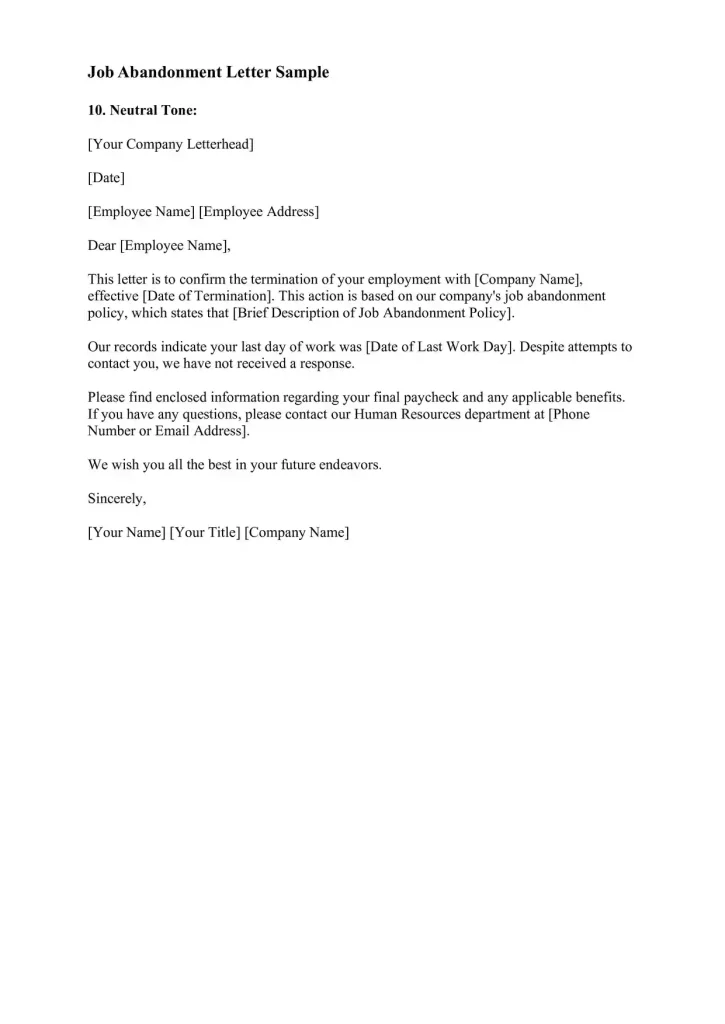
Job Abandonment Template
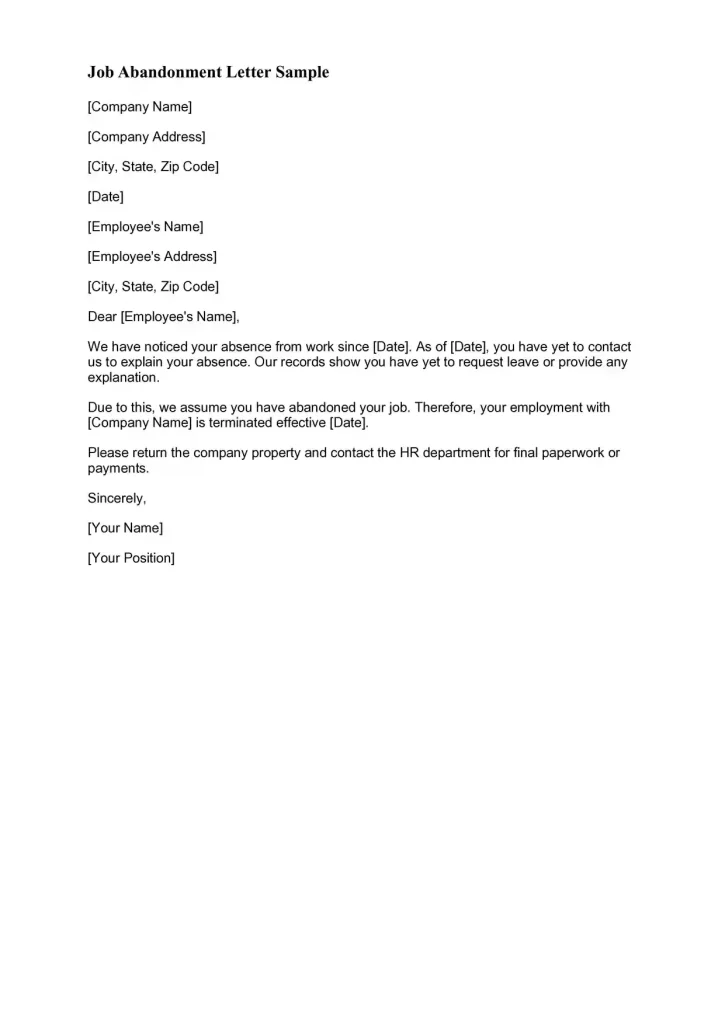
Different Types of Job Abandonment Letters
Each type serves a specific purpose, depending on the situation. Here are the common types:
Initial Warning Letter
Purpose: This letter is sent when an employee first stops coming to work without notice.
Content:
- A reminder of the attendance policy
- Request for the employee to contact the employer
- Warning about possible consequences if the absence continues
Final Job Abandonment Letter
Purpose: This letter is sent when the employee has yet to respond to the initial warning and is absent.
Content:
- Summary of previous communication attempts
- Statement that the employee is assumed to have abandoned their job
- Information about final paychecks and returning company property
Follow-Up Letter
Purpose: This letter is sent after the final job abandonment letter to close the process.
Content:
- Confirmation that the job abandonment process is complete
- Details about any final steps, such as returning equipment
- Information about how to receive final pay
Employers can handle different situations properly by using the correct type of job abandonment letter. This helps keep everything transparent and fair for the employer and the employee.
No Call No Show Termination Letters
Common Mistakes and How to Avoid Them
Here are some common mistakes employers make and tips on how to avoid them:
Failing to Communicate Clearly
Mistake: Not telling employees about attendance rules and what happens if they abandon their jobs.
How to Avoid:
- Set Clear Policies: Write down attendance rules in the employee handbook.
- Regular Reminders: Remind employees about these rules during meetings and through messages.
- Open Door Policy: Encourage employees to discuss any issues affecting their attendance.
Delaying the Response
Mistake: Waiting too long to deal with job abandonment can cause confusion and legal problems.
How to Avoid:
- Immediate Action: Address unexplained absences quickly. Try to contact the employee within the first few days.
- Document Efforts: Keep records of all attempts to contact the employee.
Not Documenting the Process
Mistake: Not keeping records of the job abandonment process can cause legal issues.
How to Avoid:
- Keep Detailed Records: Write down all communications and steps to contact the employee.
- Use Templates: Use standard forms and letters to ensure consistency.
Overlooking Legal Considerations
Mistake: Ignoring legal rules and potential issues.
How to Avoid:
- Consult Legal Advisors: Make sure your job abandonment policies follow labour laws.
- Follow Legal Procedures: Stick to legally recommended steps when dealing with job abandonment.
Ignoring the Root Cause
Mistake: Focusing only on the absence without understanding why it happened.
How to Avoid:
- Conduct Exit Interviews: If the employee responds or returns, ask them why they were absent.
- Provide Support: Offer resources like counselling or employee assistance programs.
Inconsistent Enforcement
Mistake: Applying rules unevenly can seem unfair and cause discrimination claims.
How to Avoid:
- Be Consistent: Apply job abandonment rules the same way for all employees.
- Train Managers: Make sure all managers understand and follow the rules consistently.
By avoiding these, employers can handle better and maintain a fair and transparent workplace.
Job abandonment is a serious issue that needs to be adequately addressed. A job abandonment letter is vital in documenting this situation and taking steps to move forward. Employers should strive to prevent job abandonment through clear communication and support.

Daniel Wilson Is a Seasoned communications professional and letter-writing expert. With over a decade of experience in corporate and non-profit sectors, Has developed a deep understanding of the power of effective communication.
Specializes in creating versatile letter templates that can be tailored to any situation. In this blog, Daniel shares a passion for the art of letter writing, offering practical tips, customizable templates, and inspiring ideas to help you communicate with clarity, confidence, and impact.






